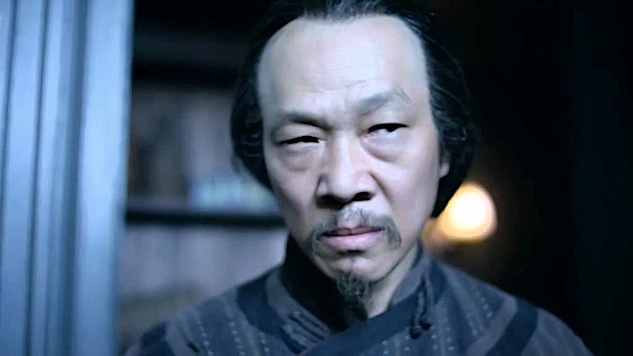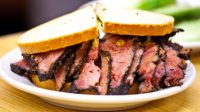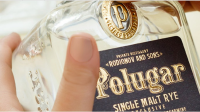Before I even watched the first episode of The Knick, I knew it would be a show for me: I am an easy mark for hospital dramas, love anything historical—especially about New York—and find portrayals of drug abuse and addiction in film fascinating. In time though, making my way through the first season, I realized my affection for the show was changing. I still found the subject matter entertaining, but more compelling were the mechanics of the show itself. The Knick is the most confounding show on television: at times cartoonish in its heavy-handedness, and then, often in the same episode, deeply subtle, a hotbed of clichéd and worn-out tropes, but often so novel, the breath literally catches in your throat.
I came to thrill in how the show would trod out a tired archetype—the handsome, damaged genius, the naïve country nurse falling for the manipulative big city surgeon, the nice guy doomed to a life of heart break—and then twist it, or draw it out in a way that would totally upset your expectations. And, time and time again, I found myself taken aback by how progressive the show was. In The Knick, issues like racism, abortion, misogyny and addiction are handled with such honesty and unflinching brutality that it can be hard to watch.
Its setting in historic New York has become one of its biggest assets and most effective tricks: as a period piece, it is able to deal with bigotry and discrimination with a kind of bleak realism that would be intolerable in a modern context. You watch the show and see black men brutally beaten by white police and think, “Wow, look at how far we’ve come.” And then, you turn on the news, or check Facebook, and see similar things happening right now and in real life, everywhere. Like all great art, for me The Knick shines a light on something universal in the human condition—in this case frailty, violence, and existential terror.
The brutality of The Knick is made even more potent by its characters who pop out as three dimensional, in a television world which is still, despite some much-lauded exceptions, defined by stereotypes. Especially when it comes to women, I have come to think increasingly that The Knick is in a league of its own. As I’ve written before, The Knick is one of a only a few series that routinely show women deep in thought, or doing their jobs with quiet competence and expertise—Mad Men was another. The Knick devotes the time and attention to show women doing the hard work of negotiating a life; and men are very rarely their primary motivation—and never their saviors.
So, I went from thinking The Knick was good, to thinking it was important. Which is why I am so disappointed, crushed, and pissed off by the show’s depiction of Asian Americans. All of The Knick’s wonderful nuance and honesty goes out the window as soon as anyone with an Asian face appears on the screen.
The show’s strengths lie in its depiction of historic New York as a diverse collection of people from all over the world: in the first season we visit “Little Africa,” see inside a black rooming house, go inside Jewish tenements, meet Poles, Irishmen, and Italians, and even though we see some of them only briefly they seem real, fleshed out and alive. In the very first episode we take a trip to Chinatown.
In fact, the entire series opens in Chinatown. We see in focus a white man’s feet in white patent leather shoes, but everything else is red-lit and out of focus. A naked Chinese woman in a flowing silk robe walks towards us and in what can only be described as a “love you long time” accent whispers in our and the protagonist’s ear: “Johnny… Johnny…”
That first scene sets up a pattern that stays true for the most part throughout the first season: Chinatown and the Chinese are seen exclusively through the eyes of a white pleasure-seeker, almost entirely inside of a brothel and opium den. It’s not that historic Chinatown didn’t have opium dens and brothels—it had many. Nor is it that the minds behind the show should not have depicted them, choosing racial sensitivity over historical accuracy. They shouldn’t have. The problem is in how they are depicted.
Every other location on The Knick is portrayed in its own gritty, unsentimental glory. Life in the Knick is hard and everyone is a victim: of circumstance, of corruption, of addiction, of disease. But not in Chinatown. For some reason, once we enter the opium parlor we also enter the white man’s fantasy of the orient. In Chinatown, everything is smoky, incensed air, welcoming silks and throw pillows, opium pipes proffered by ingratiating Chinese women in diaphanous robes, or more often naked Chinese women who are, with big smiles, selling sex as well.
With the exception of a few fun-looking bars, none of the places in this series look like anywhere you’d actually want to visit. For the most part, The Knick’s universe is violent, backwards, and corrupt. But Chinatown is depicted as a dream: things are softer there, easier—pliant Asians with their eastern lovemaking and potent drugs will make all of your troubles disappear. If you have any conception of the history of Asians in film and television in America, what else is there to say but, “here we go again.”
The scenes in Chinatown are clearly designed to titillate and excite the desires of the viewers. Just as the physical opium salon serves as an escape for Dr. Thackery, the drug-addicted but brilliant surgeon, the figurative space offers a respite for the viewer from the brutal reality of the rest of the show. And there’s a word for reducing an entire Asian culture into a western fantasy: orientalism.
Emily Nussbaum, the television critic for the New Yorker, picked up on this early in her first review of the show when she said, describing Dr. Thackery: “He’s also a junkie, who hangs out in exotic opium salons, where he is catered to by Oriental prostitutes—that seems like the right adjective, given the way that these scenes are filmed, with silent beauties offering up their breasts like kumquats.”
Still, I held out hope. The Knick has proved so good at confounding expectations: nuns become abortion doctors, naïve southern nurses go in for extreme cocaine-fueled sex and upper-crust surgeons become barroom brawlers. Surely, I thought, the same bait and switch was in store for the Asian characters. Steven Soderbergh and the obviously very smart writers behind The Knick must be aware of the dominant Asian stereotypes, both in the period-racism of turn-of-the-century America, and in the modern media landscape, of Asian women as eager but passive sex objects and of Asian men as conniving criminals with a near-magical proficiency in martial arts.
As I continued to watch Season One, the depiction of Asian Americans remained so tone-deaf I started to read it as done knowingly. I did really like the show after all, and found lots to respect in it.
It wouldn’t have been without precedent for The Knick to seem dumb while making a smart point. Maybe the racism I perceived was actually saying something more profound. So far every scene with Asians had taken place in a brothel after all, and brothels are the realm of constructed fantasy for the empowered customer. Perhaps the orientalist trappings that bothered me so much were making a larger point about immigrants having to adapt themselves to ludicrous white supremacist notions of their culture in order to survive. That must be it. Surely, once we got to see Asians outside of the opium den, their situations would be given depth.
Nope.
The first scene that showed Asians outside of the brothel, in episode six, “Start Calling Me Dad,” was so ludicrous that even now, many months later, I am still having trouble coming to terms with it.
In the scene, two of Thackery’s preferred sex workers are in the hospital watching while the doctor, in a typical bout of brilliant drug-induced mania is grappling with a daunting women’s health problem, placenta praevia. That the women were in the hospital at all might have seemed like progress; in a way the hospital is the polar opposite of the brothel. If the brothel is fantasy, the hospital is literally life and death. Except this time the women are, for no discernible reason, totally naked. Same old fantasy, just a different backdrop.
The girls of course don’t speak, so Thackery takes care of the introductions:
“This is Lin-Lin and this wonderful creature is Delores. There’s no chance in hell that’s her real name, but it seems to suit her. Now, I once met a Thai girl in the profession, swore her name was Colette Bonaparte. I suppose it’s all part of the transaction, you know? She pretends, we pretend. A good time is had by all.”
Indeed.
I’ll skip the medical details, but here’s what happens in the scene: the women watch while the doctor is testing a new medical device that amounts to a metal hose nozzle. The women, who again are naked, are mostly silent and speak no English. We are made to understand that the device is designed to be loaded with a “basketball bladder” and then vaginally inserted into patients before the bladder is inflated. We are told that Thackery has been experimenting, testing the device on the women for two days.
They look on passively. They smile. They laugh and cover their mouths. When Thackery is discovered in his work by a fellow doctor, he simply explains that “These ladies work by the hour, and their rate is on the high side due to their cleanliness and good humor.”
When the other doctor expresses his shock that Thackery has been working for two days straight without a break. He jokes “We took a few short breaks,” basically winking at the camera. The girls giggle coquettishly, though I don’t see how sexing their paying client constitutes taking breaks for them.Thackery then tells the other doctor to scrub in, and they get to work with all the giggly adolescent energy of two boys who have just found their parents’ pornography.
The Chinese women look on. They don’t say anything. They giggle and they smile.
That the women are passive and without agency is not nearly going far enough. They are furniture. Or, more accurately, they’re what the doctors at The Knick usually test their new devices on—cadavers. And, that this scene is meant to be sexy, as it so obviously is—two women with no idea what’s going on, being molested repeatedly over 48 hours by their fully clothed john and a stranger, who smirk and take notes—boggles the mind.
Perhaps the brothel scenes were offensive, perhaps they were clichéd but they also might have been real. There is nothing realistic about the hospital scene, no reason for all the smiling, sexily-lit nudity; it doesn’t deepen our understanding of the characters or further the plot. It is meant to titillate and to entertain. A weird, ugly, little racist dirty joke.
If the sex workers spoke English or were subtitled, maybe we could at least get an idea of their perspective, discern if there is artifice behind their willing submission to the doctor’s medical experiments. Maybe they really are happy to help, proud to be a part of something that can save other women’s lives. But these women are Chinese. They don’t speak. They only smile and laugh, like presumably the viewers are supposed to.
The one Chinese character who does speak English is Ping Wu, proprietor of the opium den, pimp, and as we come to find out, assassin. Wu is already such a ball of stereotypes that when he finally is revealed to be an expert at martial arts, dispatching two rooms of hardened gangsters by basically spinning around with knives—and finally killing the gang leader by throwing a hatchet into his forehead from across the room—I actually laughed out loud. It’s like the writers were trying to win stereotype bingo.
The Knick writers have said on Twitter that they based Ping Wu on a few real Chinese gangsters, one of whom, like Wu, “wore chain mail + carried a hatchet.” They don’t say who exactly, but my guess was that Mr. Ping is based on Sai Wing Mok—which actor Perry Yung recently confirmed in a Reddit AMA. Sai Wing Mok is an incredible character who came to New York and fought his way to the top of the Chinese underworld, before ultimately brokering a peace deal between the Chinese gangs and the U.S. government and retiring to Brooklyn. You could make a compelling television drama from his Wikipedia page alone. If Ping Wu’s storyline eventually turns out to be more like Sai Wing Mok’s, that would be awesome, and I really hope they go in that direction.
But the depictions of Asians in Season One were so egregious, I honestly expected some sort of ham-fisted, self-aware gesture in Season Two, à la Lena Dunham. And the first Asian face we see in the Season Two premiere is a doctor’s. Sadly, Dr. Fang only has about two lines.
However, we do get to see San Francisco’s Chinese population unfairly quarantined, and we also see some more overt anti-Asian prejudice on the part of the white police. In the world of the The Knick, hate humanizes you and I suppose that amounts to progress.
The power dynamics around Ping Wu have also changed in Season Two. He now has a hospital administrator in his pocket and has been steadily growing his criminal empire. He is a character with real power; ethically bankrupt, but powerful.
There is another scene of a grinning doctor examining an Asian sex worker, but this time it’s played to be creepy, not sexy. Again, progress, I guess.
Now that we are seven episodes into the second season I think it is fair to say that anyone expecting real progress in the show’s depictions of Asian Americans will be disappointed. There have been two scenes of Asian prostitutes being examined at the Hospital. The second scene is only interesting in that it reveals Lin Lin does indeed speak English, making the hospital scene in season one all the more disturbing.
And there are two more scenes with Ping Wu—one in which the camera stays mostly on his hands while he counts money, uses an abacus, drinks tea, and discusses Confucius. And there’s another in which we see him indulging his foot fetish—there is not enough room here to go into the very real fetishization of the foot in traditional Chinese culture, or that fetishization’s subsequent fetishization by the west, but suffice to say it’s a thing.
Now again this is not to say that Chinese people didn’t drink tea, or discuss Confucius, or use abaci. But, since we have been shown so little of Ping Wu, it is hard not to see these Chinese-signifyers all loaded into one brief scene as tropes meant to do the work of real character development.
In his Reddit AMA, Yung revealed a deep knowledge about the history of Asians in America and this country’s many chinatowns, even discussing the Anti-Chinese Exclusion Act of 1882. He gives Steven Soderbergh credit for allowing him to act, using his own voice and not taking on an exaggerated Chinese accent. And he also acknowledges that “Ping Wu represents an archaic stereotype in many ways,” but says what drew him to the character was “how they made Ping Wu a multi-faceted person, not a flat stereotype.”
Later in the conversation he goes on to reveal more about Ping Wu’s character and backstory:
“Aside from operating a brothel and opium den, Ping Wu is also a classically educated Chinese scholar. He strives toward self-mastery in mind and body. However, he really gets knotted up by dirty dishes left in the sink!”
It’s too bad that very little of that humanity—if any—has shone through on screen. In the same way that other prestige dramas have struggled with developing those characters who aren’t white or male, The Knick will have to start addressing its very real problem with Orientalism, before these issues begin to overwhelm all that is great about the series.



